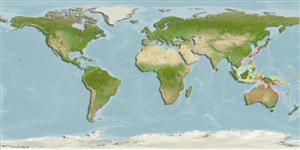>
Ovalentaria/misc (Various families in series Ovalentaria) >
Pomacentridae (Damselfishes) > Microspathodontinae
Etymology: Parma: Latin, parma, -ae = a little shield.
More on author: Whitley.
Environment: milieu / climate zone / depth range / distribution range
Écologie
marin récifal; non migrateur; profondeur 2 - 20 m (Ref. 7247). Tropical
Western Pacific: eastern Australia between Cape Tribulation, Queensland and Sydney, New South Wales.
Taille / Poids / Âge
Maturity: Lm ? range ? - ? cm
Max length : 16.5 cm SL mâle / non sexé; (Ref. 7247)
Description synthétique
Morphologie | Morphométrie
Épines dorsales (Total): 2; Rayons mous dorsaux (Total): 17-20; Épines anales 2; Rayons mous anaux: 13 - 15
Museum specimens indicate that this species is probably most abundant in non-coral reef coastal waters, although one specimen at the Australian Museum was taken at Great Island on the Great Barrier Reef, Australia. Life history characteristics for the family specify that this group is oviparous, with distinct pairing during breeding (Ref. 205). Eggs are demersal and adhere to the substrate (Ref. 205). Males guard and aerate the eggs (Ref. 205). Diurnal species (Ref. 113699).
Life cycle and mating behavior
Maturité | Reproduction | Frai | Œufs | Fécondité | Larves
Life history characteristics for the family specify that this group is oviparous, with distinct pairing during breeding (Ref. 205). Eggs are demersal and adhere to the substrate (Ref. 205). Males guard and aerate the eggs (Ref. 205).
Allen, G.R., 1991. Damselfishes of the world. Mergus Publishers, Melle, Germany. 271 p. (Ref. 7247)
Statut dans la liste rouge de l'IUCN (Ref. 130435)
Menace pour l'homme
Harmless
Utilisations par l'homme
Plus d'informations
Taille/ÂgeCroissanceLongueur-poidsLongueur-longueurFréquences de longueursMorphométrieMorphologieLarvesDynamique des populations larvairesRecrutementAbondanceBRUVS
RéférencesAquacultureProfil d'aquacultureSouchesGénétiqueElectrophoresesHéritabilitéPathologiesTraitementNutrientsMass conversion
Outils
Articles particuliers
Télécharger en XML
Sources Internet
Estimates based on models
Preferred temperature (Ref.
123201): 24.3 - 28.2, mean 26.9 °C (based on 680 cells).
Phylogenetic diversity index (Ref.
82804): PD
50 = 0.5010 [Uniqueness, from 0.5 = low to 2.0 = high].
Bayesian length-weight: a=0.01950 (0.00922 - 0.04124), b=3.00 (2.82 - 3.18), in cm total length, based on LWR estimates for this (Sub)family-body shape (Ref.
93245).
Niveau trophique (Ref.
69278): 2.7 ±0.24 se; based on food items.
Résilience (Ref.
120179): Milieu, temps minimum de doublement de population : 1,4 à 4,4 années (Preliminary K or Fecundity.).
Fishing Vulnerability (Ref.
59153): Low vulnerability (10 of 100).
Nutrients (Ref.
124155): Calcium = 81.5 [41.5, 129.3] mg/100g; Iron = 0.655 [0.404, 1.069] mg/100g; Protein = 18.2 [17.1, 19.4] %; Omega3 = 0.101 [0.063, 0.161] g/100g; Selenium = 23.1 [13.1, 42.9] μg/100g; VitaminA = 83.2 [22.9, 279.6] μg/100g; Zinc = 1.59 [1.10, 2.29] mg/100g (wet weight);
